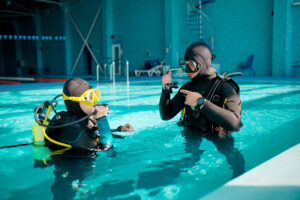What is a J-valve?
The J-valve is a critical component of scuba diving equipment, specifically designed to provide divers with a reserve air supply during their underwater adventures. This ingenious and practical valve system has been an integral part of scuba diving history, revolutionizing the sport and making it safer for divers of all levels. In this entry, we will explore the development, functionality, and application of the J-valve in the context of scuba diving.
Historical Development
The invention of the J-valve can be traced back to the 1950s when scuba diving was still in its infancy. As the sport grew in popularity, divers and engineers sought ways to improve diving safety and efficiency. At the time, the standard scuba cylinder was equipped with a simple on/off valve. However, this design left divers vulnerable to running out of air without warning, leading to potentially life-threatening situations.
The J-valve was created to address this safety concern, providing divers with an essential backup air supply. The valve quickly gained popularity among the diving community and became a standard feature on many scuba cylinders throughout the 1960s and 1970s.
Functionality
The J-valve is a spring-loaded scuba cylinder valve that operates based on the pressure within the cylinder. Its primary function is to shut off a diver’s air supply automatically once the cylinder pressure reaches approximately 300 psi (pounds per square inch). This pressure threshold ensures that the diver is left with a reserve air supply to facilitate a controlled ascent to the surface in case of emergency.
The valve is composed of two main parts: the reserve lever and the rod. The reserve lever is a small metal flap located within the valve, which is held in place by the spring mechanism. The rod is attached to the reserve lever and protrudes from the valve, allowing the diver to manually activate the reserve air supply.
When the cylinder pressure drops to the predetermined level, the spring mechanism within the J-valve forces the reserve lever to move, effectively blocking the flow of air to the diver. To access the reserve air supply, the diver simply pulls the rod, which in turn lifts the reserve lever and re-establishes the air flow.
Application in Scuba Diving
The J-valve has been an essential piece of equipment for many divers, particularly during the early days of scuba diving. It allowed divers to monitor their air consumption and provided an additional safety measure in case they miscalculated their remaining air supply.
However, with the advent of more sophisticated dive computers and submersible pressure gauges, the J-valve has seen a decline in popularity. Many modern divers prefer using these devices to track their air consumption, as they provide a more accurate and real-time assessment of the remaining air supply. Additionally, some argue that the J-valve can create a false sense of security, leading divers to neglect proper air management practices.
Despite these concerns, the J-valve remains a valuable piece of diving history and a testament to the continuous efforts to improve diving safety. Some divers, particularly those with a penchant for vintage equipment or seeking redundancy in their air supply systems, still choose to use J-valves today.
Advantages and Disadvantages
The J-valve offers several advantages, including:
- Reserve air supply: The primary benefit of the J-valve is the reserve air supply it provides, allowing divers to make a controlled ascent to the surface in case they run out of air.
- Easy to use: The simple design of the J-valve makes it easy to operate, even for novice divers.
- Historical significance: The J-valve is an important part of scuba diving history and offers a unique connection to the sport’s early days
- Redundancy: For divers who value having backup systems, the J-valve can serve as an additional layer of safety, complementing modern dive computers and submersible pressure gauges.
However, the J-valve also has some drawbacks:
- False sense of security: Some divers argue that relying on the J-valve can lead to complacency in air management practices, potentially putting divers at risk.
- Incompatibility with modern equipment: As dive technology has evolved, the J-valve has become less compatible with modern scuba systems, making it a less practical option for many divers.
- Limited availability: With the decline in popularity, J-valves and compatible cylinders have become less common and may be more challenging to find, particularly for rental purposes.
Maintenance and Care
As with any scuba diving equipment, proper maintenance and care of the J-valve are crucial to ensure its functionality and longevity. Regular inspection and servicing by a qualified technician are necessary to verify that the valve is in good working condition. Divers should pay particular attention to the following aspects:
- Spring mechanism: The spring within the J-valve should be inspected for any signs of corrosion, wear, or damage. A faulty spring may not trigger the reserve lever at the appropriate pressure, rendering the valve ineffective.
- Reserve lever and rod: The reserve lever and rod should be checked for any signs of damage, ensuring that they move freely and smoothly.
- O-rings: The J-valve features O-rings that help maintain airtight seals. These should be inspected for wear and replaced as needed to prevent air leaks.
- Cleaning: After each dive, the J-valve should be rinsed thoroughly with fresh water to remove salt, sand, and other debris. This helps prevent corrosion and keeps the valve functioning optimally.
Key Takeaways
The J-valve, with its rich history and practical design, has played a significant role in the evolution of scuba diving. Despite its decline in popularity due to advancements in dive technology, the J-valve remains a testament to the continuous efforts of divers and engineers to improve the safety and efficiency of underwater exploration. For those who appreciate the simplicity and historical significance of this classic device, the J-valve continues to offer a valuable backup air supply system for scuba diving adventures.
















